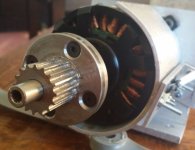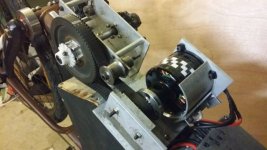The belt from the motor to first gear broke about 3weeks ago, Ok I was doing burn outs in the shed.
Anyway, after this happen I pulled out the old motor and made some new mounts for the
new motor and had it running 3days ago. I even manged to make my own 16tooth pulley with out
needing the mill as I don't have a dividing head.

I am not to happy with my crappy mounting of the motor and gears
and plan on rebuilding this to try and get away from the DIY look.
Currently learning to use solid works so will draw up my new design on that.

This motor has an inductance of 10uH and so far the controller is doing well.
But I really need to change the DC-Link caps now as they will
be extra stressed now with only 10uH.
I did have a 40uF PP cap waiting to be fitted but I manged to mess up
and it will not fit, so now have five 470uF caps with a ripple current rating of 2.4amps
at 100KHz @ 105°C. This was all based for the 30uH motor but this 10uH motor has messed things
up a little bit.
Using 10uH motor and 15KHz PWM with a min battery voltage of 38volts gives me a ripple current of
44amps.

Ripple Current: Using HighHopes Guide.
delta_I = d*(1-d)*Vbus/(f*L)
delta_I = 0.5*(1-0.5)*38V/(15kHz*10uH)
delta_I = 63App or 44Arms
So, I am a long way from having enough caps but I am still going ahead
with the 5 x 470uFcaps and we will see how long it takes for the caps to open up like the
eggs in the Aliens movies.
I may have to increase PWM freq to 20KHz to help reduce the ripple current.
So far I have only done two short rides with the new motor and due to the lower motor inductance
I am now pulling up to 70amps batt current (2500watts).
Looks like I forgot to back-off the Avg current setting which was left at 75amps
as the old motor could never draw that much current.
In a week or so I will try increasing the phase to 150amps, and will get some scope pics
of a lowside gate and a phase output. I may have to increase desat to 300amps as well
if I increase the phase current.
I was going to build a 12fet controller but this is a waste of time at the moment as I don't
think my bike components ( chain and the timing belt ) will handle 5kws,
so I have decided to make the 6fet controller again but smaller, use a 40 pin PIC
and layout the digital board so it is pin compatible with Lebowski's Controller chip.
The aim is to try and make this bike not look DIY as much as possible which is funny, as
5 months ago the aim was to make a controller that lasted longer than 5mins.
I don't think this project will ever end




